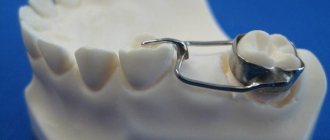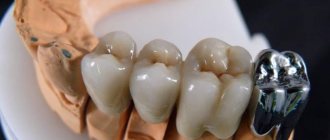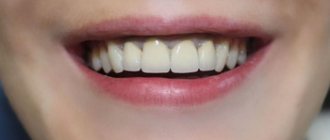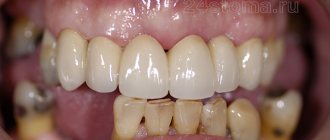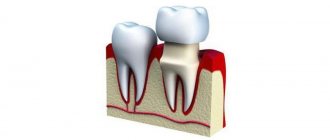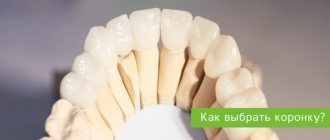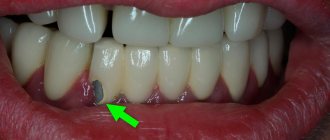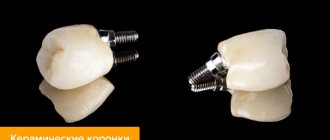Prostheses made from zirconium dioxide are almost ideal in quality; due to its properties, it is also used for the production of implants and abutments. On the other hand, the answer to the question of which is better in terms of cost is also obvious. Many patients are not satisfied with this option due to the high financial costs, so they choose metal ceramics as a cheaper solution.
Metal-ceramic crown
This is a prosthetic structure consisting of a metal frame and a ceramic coating applied to it. It is made from nickel-chromium or cobalt-chromium alloy. The crowns are very durable, and thanks to the ceramic veneer, it is possible to imitate the natural color and shine of teeth.
Advantages:
- affordable price;
- aesthetically attractive appearance;
- ability to withstand heavy chewing loads;
- resistance to deformation and displacement;
- does not cause irritation of the mucous membrane;
- does not fade over time;
- is settling in well.
Flaws:
- before installing the prosthesis, it is necessary to grind the teeth (up to 2 mm around the entire circumference);
- Depulping is mandatory;
- there is a risk of exposing the crown frame;
- translucency of the base is observed when the ceramic layer is naturally erased.
Rules for caring for dentures
You shouldn’t think that if dentures last 20 years, look natural, are strong and durable, then you don’t need to take care of them. This is a misconception, since artificial teeth also need to be thoroughly cleaned of plaque and bacteria twice a day, and the mouth should be rinsed after eating food. In addition, in addition to teeth, in the oral cavity there are gums and a tongue, on which harmful bacteria also constantly accumulate.
To make dentures and the surrounding teeth look as attractive as possible, you must not forget about regular visits to the dentist. You need to visit a doctor (even two – an implantologist and a hygienist) 1-2 times a year for a preventive examination and comprehensive oral hygiene.
Zirconium crown
This is the latest development in the field of dental prosthetics. The crown contains no metal elements; the frame is made of zirconium dioxide, and the outer covering is made of porcelain enamel.
Advantages:
- hypoallergenic;
- low likelihood of rejection and negative reactions;
- crowns are perceived by the body as bone tissue, since their physical and chemical properties are very similar;
- teeth need to be ground down only 0.4 mm;
- minimal risk of inflammatory processes;
- high strength (zirconium crowns are 30 times stronger than metal-ceramics);
- resistance to coloring with food dyes;
- natural appearance;
- painless and fairly simple installation.
Flaws:
- high price;
- complex and labor-intensive manufacturing technology.
Popular and quality brands
The material is considered one of the most difficult to manufacture, and only large companies can and can produce truly high-quality workpieces (zirconium dioxide blocks and disks). Among the brands and brands popular among dentists are the following:
- IPS e.max from Ivoclar Vivadent (but not ceramics, namely zirconium blocks - ZirCAD and ZirPress models). This company also develops pressed ceramics for restorations,
- Prettau from Zirkonzahn is a relative newcomer in the field of prosthetics, allowing you to create innovative crowns without ceramic veneering,
- Zirconia Meso from CEREC.
How does the crown installation process work?
Metal-ceramic dental prosthetics is a long process that takes several stages. First, the patient will have to cure caries and other diseases of the oral cavity, then the enamel will be ground down and the nerve will be removed (if necessary). After this, an impression is made of the prepared tooth, which will be sent to a dental laboratory to make a crown (this can take up to 2 weeks). Then the fitting and adjustment of the structure is carried out.
The process of installing zirconium crowns is as follows:
- The patient undergoes an initial examination of the oral cavity by an orthodontist; if inflammatory processes are detected, further treatment will be required.
- The doctor grinds the tooth for the future crown and makes silicone impressions.
- The impressions are sent to the dental laboratory. The crown is modeled on a computer and then manufactured using high-precision milling equipment. The finished prosthesis is fired and painted.
- The crown is installed in the oral cavity using cement mortar. The procedure takes from 30 minutes to 3 hours.
How to choose?
The disadvantages and advantages of both materials can be summarized in the form of a table:
| Parameter | Metal ceramics | Zirconium dioxide |
| Turning | Minimum 1.5mm grind required on each side | Turning is minimal |
| Depulpation | In most cases it is done, with the exception of the chewing group. | It is done only in the presence of pulpitis. With a healthy pulp, in most cases the tooth can be kept alive. |
| Aesthetics and its stability | The crown does not differ from the teeth only at first, then the metal begins to show through. In addition, when the gums recede, a rim appears at its junction with the prosthesis. | Thanks to light refraction, dentures are indistinguishable from teeth, and the aesthetics remain stable throughout their entire service life. |
| Strength | High | High |
| Biocompatibility | Over time, the metal may begin to oxidize. The material is not suitable for people allergic to metal. | Absolute biocompatibility and hypoallergenic. |
| Production time | Long-term, several visits to an orthopedist are required. | When using the CAD/CAM system, the prosthesis can be manufactured and installed in one appointment. |
| Price | From 60 dollars | From $260 |
The table clearly shows the differences between metal ceramics and zirconium. The choice will ultimately depend on the condition of the oral cavity, which teeth require a crown, and financial capabilities. If there are several teeth that require replacement, doctors usually recommend using metal-ceramics for the chewing group, and placing zirconium oxide crowns on the visible front teeth.
Sources:
- Lebedenko I.Yu., Bragin E.A., Kalivradzhiyan E.S. Orthopedic dentistry. Moscow, 2012.
- Kopeikin V.N. Orthopedic dentistry. Textbook. Moscow, 2001.
Quality indicators of materials
| Indicators | Zirconium dioxide | Metal ceramics |
| Strength | Very high | High |
| Lifetime | 20 years or more | Up to 10 years |
| Impact on the body | Low risk of allergies | There is a possibility of oxidation and allergic reactions |
| Color preservation | Color does not change | Color does not change |
| Thickness | 0.3-0.4 mm | 1.5-2 mm |
| Price | From 15,000 rub. | From 7000 rub. |
Good to know. Many patients are not satisfied with the high cost of zirconium crowns, so they choose metal-ceramics as a cheaper option.
Zirconium dioxide frameworks
Zirconium dioxide is a material that is increasingly replacing metal alloys for the manufacture of frames for crowns, bridges, and abutments.
In medicine, it was initially used for the manufacture of joint prostheses, and since 1993 it has found application in dental practice. Dental structures made of zirconium dioxide can be installed on both anterior and chewing teeth. Due to the ability to transmit light, the products are very difficult to distinguish from natural teeth in any lighting.
Advantages of zirconium dioxide structures:
- Safety. Zirconium dioxide in its chemical and physical properties is close to dental tissue, in addition, it is hypoallergenic. During the entire period of use of the material in medicine, not a single case of an allergic reaction has been recorded. These properties of zirconia make it almost the only option for treating patients with metal allergies;
- Strength and durability. Zirconium dioxide frames are almost as strong as metal frames. Zirconium dioxide, unlike metal, does not deform over time;
- Small thickness (only 0.4 mm). This allows the dentist to preserve more of the patient’s own dental tissue when preparing teeth for dentures, and the design is lighter;
- Low thermal conductivity. The zirconium dioxide frame is a good heat insulator that protects the tooth pulp from temperature changes. This property of the zirconium frame allows you to keep the teeth under the crowns “alive”;
- The technology for making prostheses from zirconium dioxide differs from the technology for creating metal-ceramic products. The frame for the prosthesis is made after 3D digitization of the patient’s dentition, the parameters of the dental structure are set using computer programs, the calculated structure is transferred to a milling machine for turning the frame from a zirconium blank. The technology makes it possible to take into account the smallest details of the tooth with high accuracy, and the permissible gap between the prosthesis and the tooth is reduced from 100-300 microns to 30 microns. This means that the contact between tooth and crown will be as precise as possible, reducing the risk of tooth decay under the structure.
Zirconium dioxide is an excellent material for making effective, safe and beautiful dental prostheses.
Is it possible to put metal ceramics and zirconium on implants?
Crowns made from these materials can be placed on implants. If we are talking about prosthetics for the front teeth, it is better to choose a ceramic prosthesis, the abutment of which is made of zirconium dioxide. When restoring teeth in the lateral jaw, metal ceramics and zirconium can be used.
It is important to know. If you decide to install metal-ceramic dentures, be prepared for the fact that your teeth will be severely ground and depulped.
To install crowns made of metal ceramics or zirconium dioxide, you can contact the Saint-Dent Clinic in Moscow. It employs qualified specialists with extensive experience in providing dental services. You can find out about the prices for installing dentures in this PRICES section. The clique's contacts are located here CONTACTS.
Content
- What crowns are used?
- Comparison of zirconium and metal-ceramic crowns
- How to choose material
- The best dentures
Restoring missing teeth is a labor-intensive and quite expensive process. In addition, there are a lot of options and choosing the right one without the appropriate knowledge is problematic. Often, patients have to choose a crown for a tooth made of zirconium or metal-ceramics, since these are the options that are used most often than others.
Possible problems and complications
| Metal-ceramic crowns | Zirconium crowns |
| Inconsistency between the color scheme of dentures and the natural dentition. Incorrectly selected prosthesis size. Poor fit of the crown. Increased tooth sensitivity. Fallout or displacement of the structure. | Increased tooth sensitivity. Poor fit of the prosthesis to the dental tissues as a result of improper turning. Unsatisfactory appearance of the crown. |
Comparative characteristics of the best crowns
To determine which crowns are the best , you need to study the pros and cons of each product, taking into account the material used.
Next, we will compare the key parameters of various prosthetic options:
| Crown | pros | Minuses |
| Made from metal-ceramics using precious metals | Has increased strength, has a natural appearance, does not cause allergization of the body | High price |
| Made from metal-ceramics using non-precious metals | It is famous for its sufficient strength, has a reasonable price and good aesthetic parameters | There is a possibility of allergy |
| Made of ceramic material | Features impeccable aesthetic parameters and absolute compatibility with the patient’s body | Increased fragility |
| Made of zirconium material | Excellent aesthetic properties, long period of operation, absolute compatibility with the body, absence of allergic reactions | Impressive value |
| e.max crowns | Unsurpassed aesthetics, increased strength, excellent light transmittance. Emax Press has a gradient of color and transparency. | High price. Only single crowns can be installed in the chewing region. |
Which crown to choose: expert recommendations
- Both zirconium and metal-ceramic crowns have good functionality and an attractive appearance. Therefore, the main factor when choosing a prosthesis will be the material component, since the difference in price is quite significant.
- Zirconium dioxide crowns are ideal for prosthetics on dental implants. But if the patient suffers from increased abrasion of the tooth surface, it is better not to place them, as this may further aggravate the situation.
- Metal ceramics are more suitable for chewing teeth. If the patient’s financial capabilities allow him to install zirconium prostheses, it is better to give them preference. They have better characteristics and will last longer than metal-ceramic dentures.
What are the contraindications?
There are no direct contraindications to the installation of zirconium prostheses[1] - because the material does not provoke allergies or irritation. But there may be contraindications to installing an implant. This primarily includes serious diseases that weaken the body - cardiovascular, endocrine, and oncological. Also, implants cannot be placed in people with increased tone of the masticatory muscles, tuberculosis, poor blood clotting, or decompensated diabetes mellitus.
Read on the topic: who can and cannot get implants - a complete list of indications and contraindications.
Alternative options to frontal crowns
At the moment, there are three alternative methods that allow you to restore the crown part of the tooth, with destruction of no more than 50%. These include:
- Veneers. Suitable for use if there is slight destruction of the outer surface of one of the front teeth. An important requirement for carrying out a procedure using such plates is the preservation of the tooth wall from the inside. Through veneers, unsurpassed aesthetics are achieved, the possibility of tooth preservation is ensured and it is possible to significantly extend the life of the tooth;
- Dental implants. If it is necessary to reconstruct 1-2 teeth and install bridge-like prosthetic devices, it is advisable to fix the implants instead of preparing the supporting units;
- Filling material. As mentioned earlier, the option with light-composite restorations is preferable when the coronal part of the tooth is destroyed by no more than 50%.
